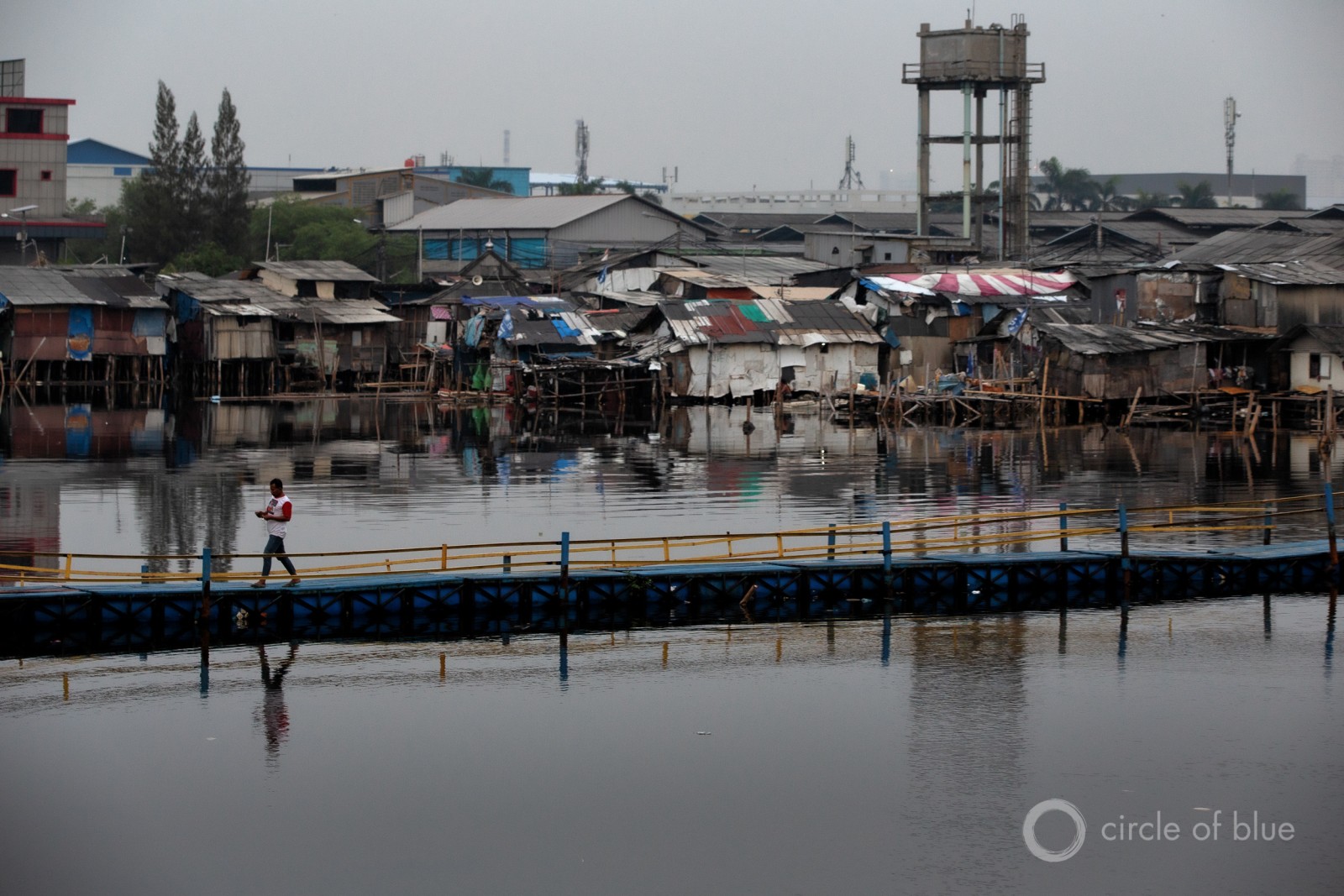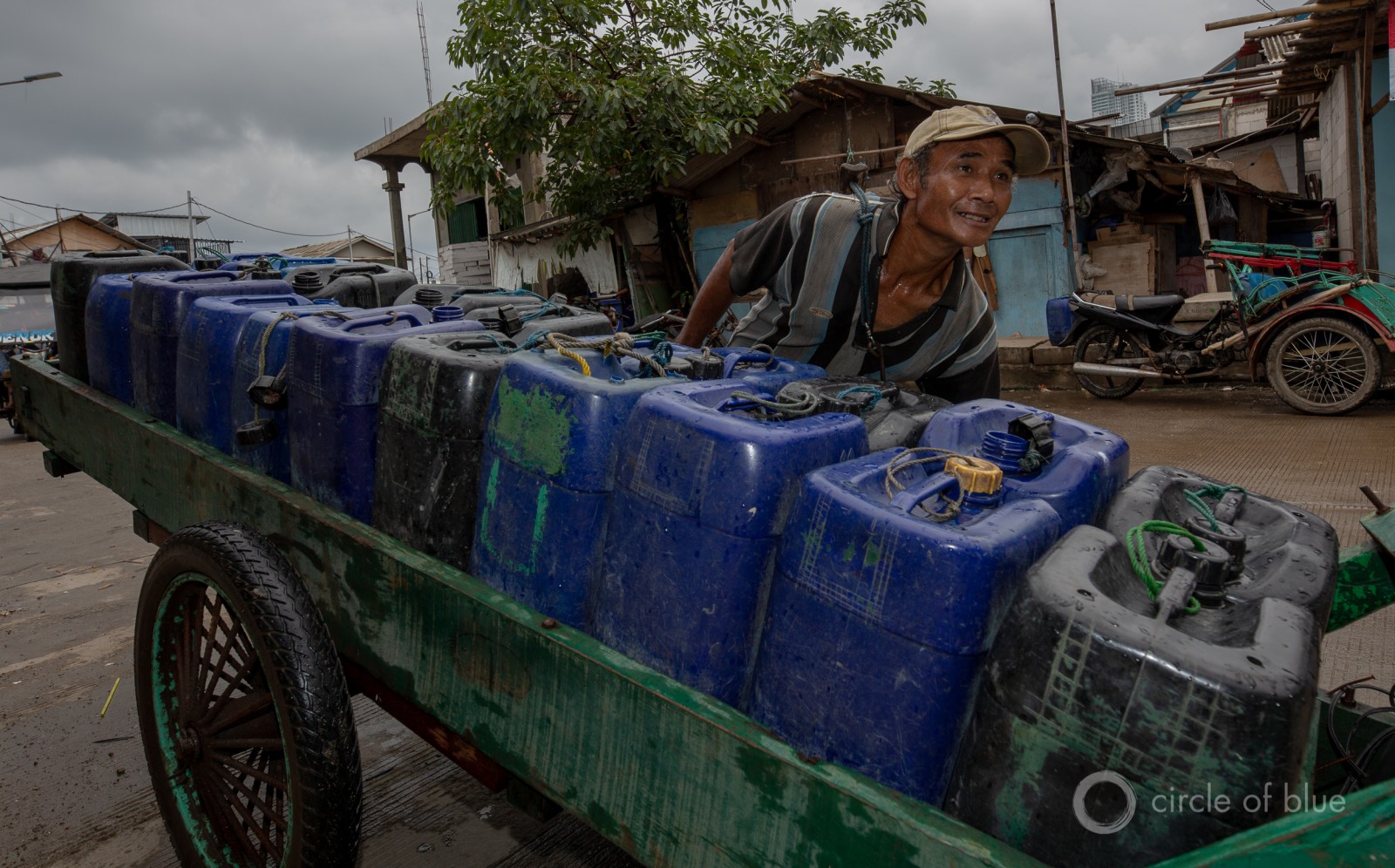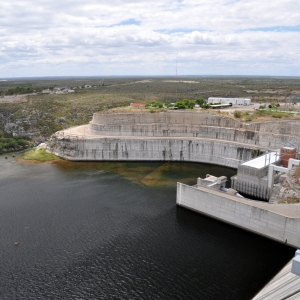Depending on how effectively they are addressed, water issues could slice between 4 and 7 percent from Indonesia’s GDP in 2045.

Jakarta, Indonesia in 2019. Photo © J. Carl Ganter / Circle of Blue
- A new report from the World Bank found that the majority of Indonesia’s population is exposed to water pollution, while only 12 percent of people have access to safe water. All but 7 percent of groundwater exceeds safe pollutant thresholds.
- Pollution and poor sanitation are linked to the country’s staggering child stunting rates, which affect 35 percent of children under age 5.
- Taken together, water-related threats could cut Indonesia’s 2045 GDP by over 7 percent.
By Laura Gersony, Circle of Blue — January 31, 2022
For decades, Indonesia’s largest city has been sinking into a water crisis. Jakarta’s descent is literal. The northern margins of the megacity, which once stood on solid ground, are now an island network of abandoned buildings. Some districts are sinking more than 20 centimeters, the height of a road curb, every year—a tribute which the sea exacts from the city of 10 million people for unsustainable consumption of groundwater.
Jakarta’s subsidence is a symbol of the manifold and long-ignored water threats that haunt the country: a list that includes paltry sanitation networks, polluted rivers, lack of water storage, regulatory dysfunction, and more.
A new report from the World Bank, Indonesia Vision 2045: Toward Water Security, quantifies the crisis. Not addressing these water-related problems could cut Indonesia’s GDP by over 7 percent by 2045, the study found. There is a silver lining, though. Proactive measures to fix these deficiencies could buffer the negative impact by 3 percent.
“Water is a key contributor – or rather prerequisite – for socio-economic development,” co-author Abedalrazq Khalil wrote in a comment to Circle of Blue. “Ignoring water risks won’t only just stall economic development but actually lead to significant decline in annual GDP growth rates.”
By far the most potent threat is the country’s poor water and sanitation networks. Only around 2 percent of the population – mostly in 13 large cities – is connected to a sewer system. More than 90 percent of municipal wastewater is discharged untreated into waterways.
The majority of Indonesia’s population is exposed to water pollution, while only 12 percent of people have access to safe water. All but 7 percent of groundwater exceeds safe pollutant thresholds.
“While all challenges are very concerning, water pollution seems to be the least understood and measured challenge, with the potential to have the largest impact on Indonesia’s society, environment and economy in the medium and long term,” Kahlil wrote. The report estimates that achieving universal water and sanitation access would improve the country’s 2045 GDP by over 1 percent.

Bottled water is delivered to thirsty homes and bodegas in the slums of North Jakarta. Photo © J. Carl Ganter / Circle of Blue
The lack of water and sanitation is not, as elsewhere in the world, due to economic stagnation. A legacy of its rapid expansion during the 1980s and 90s, Indonesia’s economy is among the 20 largest in the world. The challenge instead is resource distribution. Indonesia falls “below the curve,” meaning that its provision of basic sanitation services is lower than its economic productivity would predict. The country spends only 0.2 percent of its GDP on water and sanitation, one-fifth of the amount recommended by the U.N.
This deficit has broad consequences for public health. Pollution and poor sanitation are linked to the country’s staggering child stunting rates, which affect 35 percent of children under age 5. Indonesia’s child mortality rate is 3.5 times higher than other southeast Asian middle-income countries.
The second main area for improvement is water storage capacity, which is currently a fraction of other countries with similar seasonal variability, such as Japan and Malaysia. At present, half of Indonesia’s GDP is produced in river basins that are considered in high or severe water stress. This figure will rise to two-thirds by the middle of this century. Constructing 50 billion cubic meters of water storage would be a “worthwhile investment,” the report found, boosting GDP by another percentage point.
The report’s other recommendations include limiting groundwater extraction and reducing deforestation.
The root of these diverse challenges is, at least in part, political and institutional. The study attributes the dysfunction to overlapping responsibilities across government agencies, a lack of incentives for efficient and effective water management, and “a legal and regulatory void” regarding the planning, conservation, and use of groundwater.
Taken together, the report’s prescriptions could help mitigate the threat that water insecurity poses to the country, adding 3 percent back to Indonesia’ 2045 GDP—a goal the report authors hope policymakers will embrace.
“Once the financial, tangible impact of water risks is understood, actions shall follow,” Kahlil wrote. “It needs to be seen as the necessity it is – rather than a ‘nice to have.’”
Read more from Circle of Blue: A Sinking Metropolis – Circle of Blue
Correction: A previous version of this article incorrectly stated that the report’s prescriptions could boost Indonesia’s 2045 GDP by 3 percent. The prescriptions could buffer the negative impact of water insecurity by 3 percent, resulting in a 4 percent net decrease in GDP.
Laura Gersony covers water policy, infrastructure, and energy for Circle of Blue. She also writes FRESH, Circle of Blue’s biweekly digest of Great Lakes policy news, and HotSpots H2O, a monthly column about the regions and populations most at-risk for water-related hazards and conflict. She is an Environmental Studies and Political Science major at the University of Chicago and an avid Lake Michigan swimmer.




